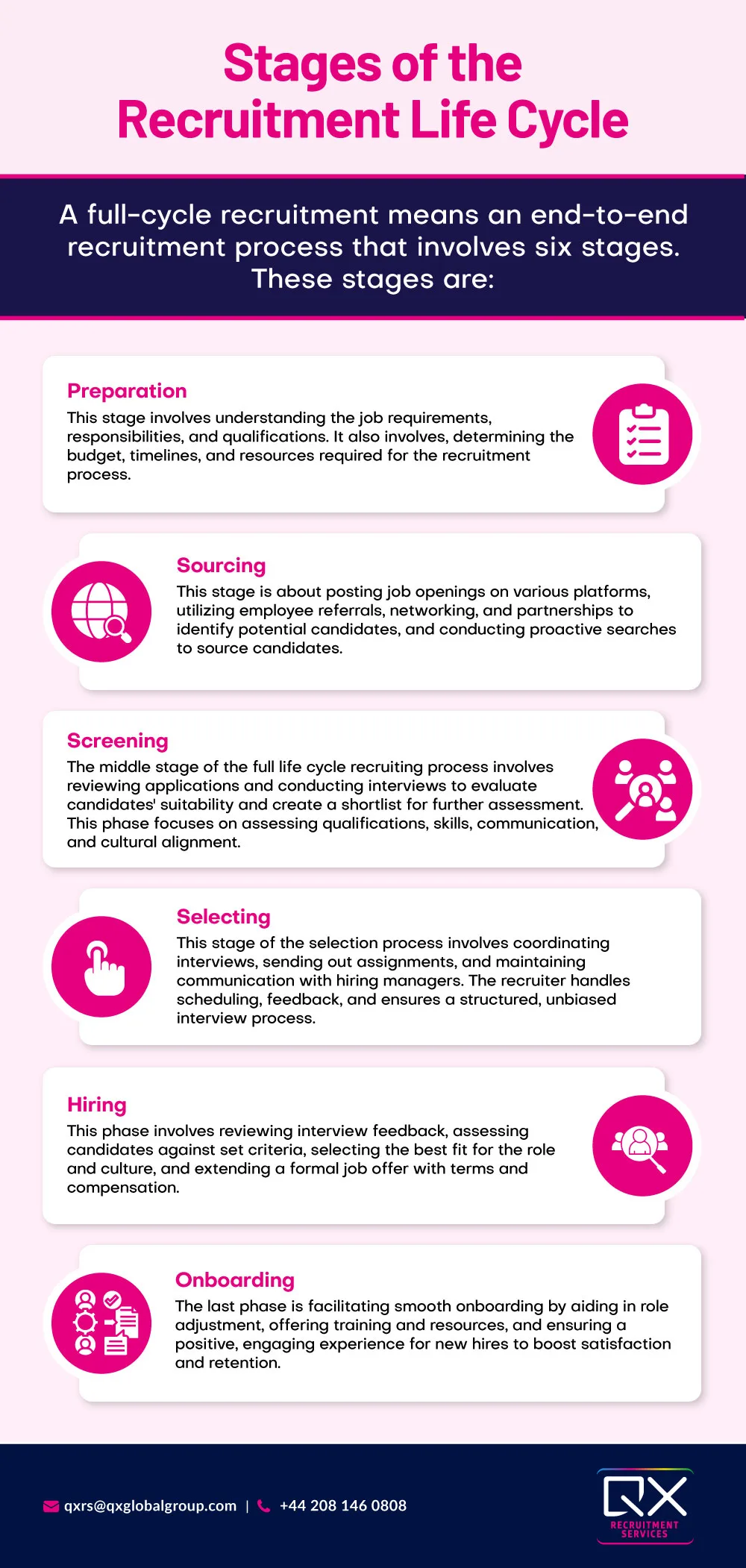Topics: Full Cycle Recruiter, Full Cycle Recruitment, Outsource Full Cycle Recruiting
Posted on September 19, 2024
Written By Sakshi Sharma

The full life cycle recruiting process is a comprehensive approach to hiring that encompasses every stage, from identifying a job opening to onboarding the new employee. This method ensures that organizations can effectively manage their recruitment efforts, leading to better candidate experiences and improved hiring outcomes. Understanding the intricacies of this process is essential for both recruiters and hiring managers alike.
Hiring managers are well-aware of the complex world of modern recruitment processes. An organized full life cycle recruiting process is a must to keep the well-oiled machine of business running.
As per a LinkedIn article, understanding how to optimize the job recruitment process can shorten the hiring cycle by 60% while improving quality.
In the world brimming with novel innovations, the integration of new technologies to perfect the recruitment process is a given. But integration does not mean replacement of human intervention.
Automating the human effort eliminates the quality in any process. We may not need more people but we need a more skilled workforce. Making the hiring process efficient requires a collaboration between humans and machines.
In this blog, we will explore human interaction in a full life cycle recruiting process. We will also understand how human interaction within these processes can be improved and how to create a balance between them.
The recruitment process can look very different for different companies but the foundation of a successful full recruitment cycle is the same.
Before getting into the intricacies of the full-life cycle recruitment process, let us understand what is a full recruitment cycle.
Full cycle recruitment, also known as end-to-end recruitment or complete recruitment process, involves the entire process of hiring an employee from the initial job opening identification to the candidate’s onboarding and integration into the organization.

Importance of Human Interaction in Recruitment: As hiring professionals know, undertaking an end-to-end recruitment process is crucial for creating a system that reduces the chances of unsuccessful hiring.
Related blog: The Key Elements of a Successful Full Cycle Recruiting Strategy
The modern recruitment process has been significantly influenced by the ongoing digital craze, changing the way organizations attract, select, and hire talent.
Digital platforms, job portals, and professional networking sites have become the go to options for both recruiters and candidates to connect and engage.
Recruiters now have access to a global talent pool, allowing for more diverse and inclusive hiring practices, while candidates can explore job opportunities beyond their local vicinity, expanding their horizons.
The rise of AI, machine learning, and automation in streamlining recruitment processes has proved to be a powerful strategy.
AI algorithms can sift through large volumes of resumes, identifying top candidates based on predefined criteria. This not only saves time but also enhances the accuracy of candidate shortlisting.
Machine learning algorithms can learn from past hiring decisions to predict candidate success and cultural fit.
Automation tools can handle repetitive tasks such as interview scheduling, sending follow-up emails, and even conducting preliminary candidate assessments.
However, it is crucial to strike a balance. While technology is invaluable in modern recruitment, maintaining a human touch is equally important. The next section talks about implementing a personalized approach, timely communication, and empathetic interactions for successful recruitment.
Human interaction is fundamental in establishing trust, understanding candidate motivations, and gauging cultural fit. Face-to-face or even virtual conversations allow recruiters to delve deeper into a candidate’s personality, values, and interpersonal skills, aspects that are often challenging to evaluate solely through technology. A personal connection helps candidates feel valued and understood, positively impacting their perception of the company and their decision-making process.
Short answer is no.
A slightly long answer is the art of balance.
There’s a legitimate concern within the recruiting community about technology eroding the personal aspects of recruitment. Let us debunk this myth.
Technology should be viewed as an enabler, not a replacement, for human interaction. Automated tools and AI can efficiently handle repetitive and time-consuming tasks
Automated systems can help manage candidate communications and data, but recruiters need to step in for critical discussions, negotiations, and relationship-building moments.
Moreover, candidates appreciate the blend of modern convenience through tech and the personal touch of a human connection.
Fully utilizing these technologies require fine tuning our interactions and understanding of these systems. Here are 3 ways that technology can help enhance the human experience:
Utilize technology to automate repetitive tasks and administrative processes.
Use various digital platforms to engage candidates effectively, providing regular updates, answering queries promptly, and showcasing the company culture to build rapport and maintain ongoing communication.
Prompt AI to personalize interactions, tailoring communications and providing a seamless, personalized experience that demonstrates attentiveness and value to each candidate.
While technology streamlines processes and augments productivity, it can never replace the fundamental importance of human insight, empathy, and connection.
In today’s competitive job market, a well-maintained balance of technology and human effort is necessary for securing top talent and maintaining a thriving pipeline. Implementing a full-cycle recruitment process can be tedious. Consider outsourcing your full life cycle recruitment process with QX Global Group.
Full cycle recruiting process is often referred to as end-to-end recruiting, complete recruitment process, and total talent acquisition.
The recruitment process duration in the United States typically ranges from a few weeks to a few months, extending further for specialized or senior roles. Several factors influence the length, including industry type, role complexity, organizational size, and hiring urgency.
Related blog: Full Cycle Recruiting Guide USA: Best Practices, Tips & FAQs
Originally published Sep 19, 2024 08:09:26, updated Jan 14 2025
Topics: Full Cycle Recruiter, Full Cycle Recruitment, Outsource Full Cycle Recruiting